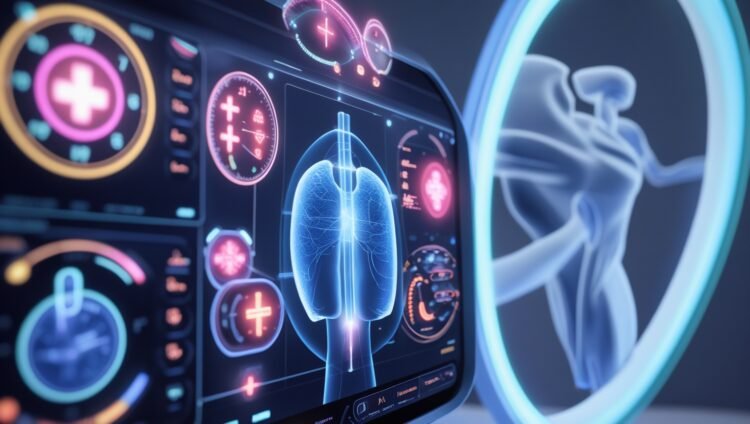The Future of Digital Health
Exploring How AI, Telemedicine, and Wearable Tech Will Revolutionise Healthcare
Key Takeaways
- Digital health is driving a paradigm shift from reactive to proactive, patient-centred care.
- AI-powered education is enhancing clinical decision support and personalised training for medical professionals.
- Telemedicine is expanding access to care, reducing costs, and improving patient engagement.
- Personalised medicine is tailoring treatments using genomics, big data, and advanced analytics.
- Wearable tech will transform remote monitoring, early detection, and chronic disease management by 2025.
Table of Contents
- Digital Health Evolution: Understanding the Transformation
- AI in Healthcare Education: Transforming Medical Training
- Telemedicine for Doctors: Changing Care Accessibility
- Personalised Medicine Trends: Tailoring Treatments to Individuals
- The Rise of Wearable Health Tech in 2025
- FAQ
Digital Health Evolution: Understanding the Transformation
Digital health encompasses the integration of mobile applications, artificial intelligence systems, advanced sensors, and sophisticated data platforms to enhance care delivery and patient outcomes. This shift moves healthcare from a reactive, one-size-fits-all model to a proactive, data-driven, patient-centred approach.
The global digital health market is projected to exceed $400 billion by 2025, illustrating massive investment in technology-enabled solutions. The COVID-19 pandemic served as a catalyst, making virtual care platforms and remote monitoring tools essential components of modern healthcare infrastructure. For more on how these trends evolved in recent years, see our post on digital health statistics for 2025.
Healthcare systems now recognise that digital transformation is not optional but essential for meeting patient expectations around convenience, accessibility, and personalisation.
“The future of healthcare lies at the intersection of human expertise and technological precision.”
AI in Healthcare Education: Transforming Medical Training
Artificial intelligence is shifting from theoretical concepts to practical tools that revolutionise medical education. AI-powered decision support systems analyse patient data and current literature to provide evidence-based recommendations in real time.
- Decision support: Machine learning algorithms suggest diagnoses and treatment options based on symptoms and history.
- Adaptive learning: Platforms customize content delivery to individual knowledge gaps and learning styles.
- Simulation and VR: Immersive environments allow hands-on practice in a risk-free setting.
For insights on training healthcare professionals in complex environments, check out our post on dual diagnosis explained. To understand the importance of mental health support for practitioners, see our guide on understanding the signs of burnout in healthcare.
Telemedicine for Doctors: Changing Care Accessibility
Telemedicine has evolved from an emergency workaround into a mainstream care delivery model. Doctors can now consult with patients via video, asynchronous messaging, and remote monitoring platforms.
Key benefits include:
- Expanded reach to rural and underserved areas
- Reduced travel time and costs for patients
- Real-time data sharing for better clinical decisions
*“Telehealth bridges the gap between patients and specialists, regardless of geography.”*
Moreover, digital tools are being integrated into chronic disease management, mental health services, and post-operative care, improving both outcomes and patient satisfaction.
Personalised Medicine Trends: Tailoring Treatments to Individuals
The convergence of genomics, big data analytics, and machine learning is enabling truly personalised treatment plans. Physicians leverage patient-specific information—genetic profiles, lifestyle data, and real-world evidence—to tailor therapies:
- Pharmacogenomics: Choosing drugs based on individual genetic makeup.
- Digital biomarkers: Using sensor data to predict disease progression.
- AI-driven analytics: Identifying optimal treatment pathways from large datasets.
This shift promises higher efficacy, fewer side effects, and a more efficient use of healthcare resources.
The Rise of Wearable Health Tech in 2025
By 2025, wearable devices will move beyond step counts and heart rate monitoring to advanced clinical-grade sensors capable of:
- Continuous glucose and blood pressure monitoring
- Real-time ECG and arrhythmia detection
- Early warning for respiratory issues via oxygen saturation sensors
These devices feed data into cloud platforms and AI engines, enabling predictive alerts and timely interventions without a clinic visit.
“Wearables put health monitoring directly into patients’ hands, shifting care to a continuous model.”
FAQ
What is digital health?
Digital health refers to the use of technology—mobile apps, AI, sensors, and data platforms—to improve healthcare delivery, patient outcomes, and system efficiency.
How does AI enhance medical education?
AI provides real-time decision support, adaptive learning pathways, and immersive simulations that accelerate training and improve clinical competence.
Is telemedicine here to stay?
Yes. Telemedicine has proven its value in expanding access, reducing costs, and maintaining continuity of care, making it a permanent fixture in healthcare.
What role do wearables play in chronic disease management?
Wearables enable continuous monitoring of vital signs and health metrics, allowing early detection of complications and more timely clinical interventions.

























